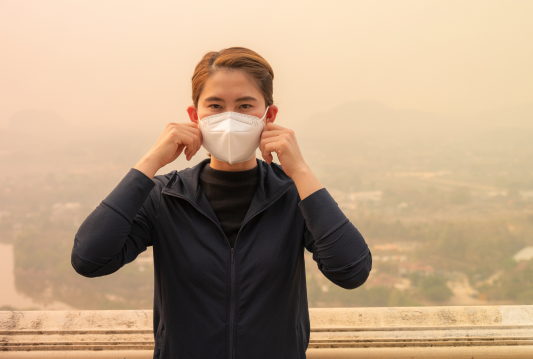Wildfire preparedness plans
Wildfire season in Canada is becoming increasingly severe., Over 1,600 wildfires occur annually in British Columbia alone, affecting businesses, employees, and communities. For employers, this growing danger presents operational disruptions and serious safety concerns.
By implementing a wildfire preparedness plan, you can safeguard both your workforce and your business. This guide outlines the essential steps every organization should take to reduce risks and enhance workplace safety during wildfire season.
Understanding the importance of wildfire preparedness
Wildfires pose unique and significant threats to businesses. Beyond the physical risks to infrastructure, wildfire smoke can compromise air quality, leading to respiratory concerns and increased health risks for exposed workers. According to Canada’s Air Quality Health Index (AQHI), prolonged exposure to wildfire smoke is linked to severe health effects like lung damage and cardiovascular complications.
Under occupational health and safety (OHS) legislation, employers must take reasonable precautions to protect employees from environmental hazards like wildfires. Failure to do so can lead to safety risks, fines, and business disruptions.
This is where effective preparedness is essential. By adopting a wildfire preparedness plan, businesses can ensure better employee safety and maintain compliance with health and safety legislation.
Review your emergency response plan
If your organization’s emergency response plan has been in place and unchanged for several years, it’s time to reevaluate it. Emergency responses and procedures can change over time, so periodic reviews ensure your plan remains effective and current.
What to review
Evacuation procedures
Establish clear evacuation routes and designated assembly points to streamline employee evacuation.
Shelter-in-place plans
Identify safe zones on the premises where employees can take refuge if evacuation isn’t immediately possible.
Communication systems
Ensure employees know how and where to receive updates during a wildfire. Options include texts, e-mails, or emergency response networks.
Emergency kits
Stock emergency supplies like bottled water, first aid kits, and face masks for smoke protection.
Regular drills
Hold evacuation and shelter-in-place drills at least once a year.
Employee training
Educate and provide employees regular training on the organization’s emergency preparedness plan.
Preparing for wildfire risks
Preparation starts with identifying how exposed your organization is to wildfire threats.
Conduct a risk assessment
Start with a location-specific risk assessment:
- Identify potential hazards like proximity to forests, grasslands, or combustible materials.
- Consider historical data, such as your region’s wildfire activity in past seasons.
- Assess employee safety, especially for outdoor roles, which are more vulnerable to smoke or fire exposure.
Tools like the Canadian Wildland Fire Information System provide interactive maps to visualize wildfire risks for specific areas across Canada.
Create awareness among workers
Provide employees with education and training on wildfire risks and the signs of smoke exposure, including:
- Eye and throat irritation;
- Coughing or shortness of breath; and
- Dizziness or fatigue.
Early recognition of these symptoms can reduce long-term health effects and prompt timely action.
Develop a wildfire preparedness plan
A wildfire preparedness plan is critical for any business, especially those in fire-prone regions. Even distant operations can be affected by drifting smoke if wind conditions change. Planning for wildfires reduces risk and improves safety for your team.
Establish responsibilities
Assign employees or form a team responsible for:
- Monitoring wildfire and air quality conditions and updates;
- Coordinating evacuation efforts;
- Regularly inspecting fire suppression and protection equipment; and
- Communicating with local fire services when necessary.
- Adjust workplace protocols as needed
During periods of high wildfire activity, consider:
- Remote work options for non-essential employees; and
- Adjusting outdoor shifts based on air quality levels.
Provide personal protective equipment (PPE)
Equip employees with tools to stay safe, such as:
- Masks or respirators to protect against smoke particles;
- Safety goggles to reduce irritation from ash particles in the air; and
- Fire protection equipment like fire blankets and extinguishers
Communicate the plan
Ensure your wildfire preparedness plan is:
- Written clearly and accessible to all employees; and
- Actively shared through communications like e-mails, notices, and meetings.
Stay updated on current wildfire alerts
Use real-time tools to make informed decisions during wildfire season. Regular updates help teams act quickly and stay safe.
- AlertReady: Canada’s emergency alerting system.
- BC Wildfire Service: information on current wildfires in British Columbia.
- Canadian Wildland Fire Information System: interactive map on wildland fire activity.
- FireSmoke Canada: Interactive map of air quality across Canada.
- WeatheCAN app: Current and forecasted weather conditions, including alerts.
Need help with emergency preparedness planning?
Planning for emergency scenarios your business might face doesn’t have to be stressful. By implementing proven strategies, leveraging the right tools, and establishing clear action plans, you can minimize the damage these costly disasters can wreak on organizations and their people. Our experts have created a free guide to help get you started with emergency preparedness planning today. Download our Guide to Emergency Preparedness and start planning for the most likely emergency scenarios your business may face.
Our Canadian-made HR software and user-friendly tools are designed to simplify HR processes like emergency planning. Looking to improve or enhance preparedness at your organization? Our live HR advice or HR consulting teams can help. Have questions? Connect with one of our experts for answers, or visit our pricing page for more information.

